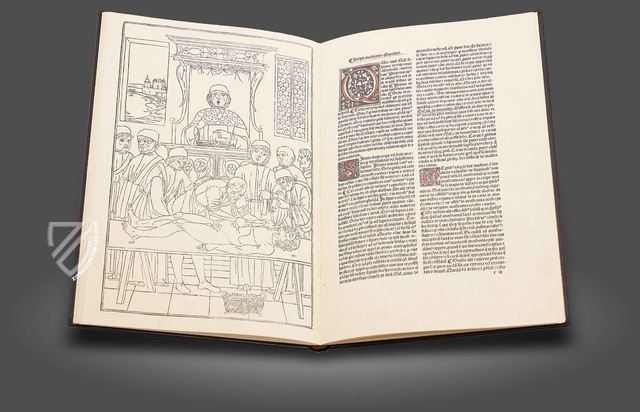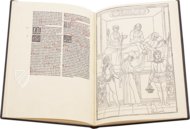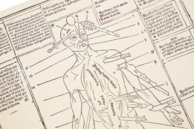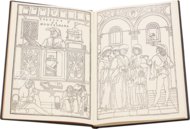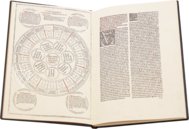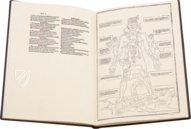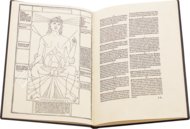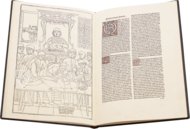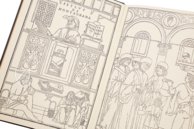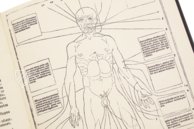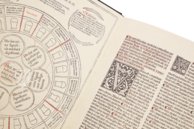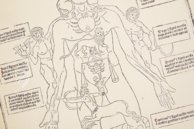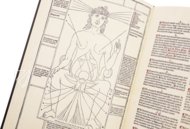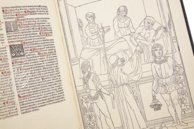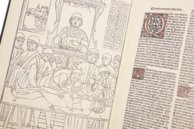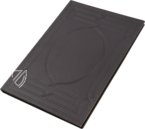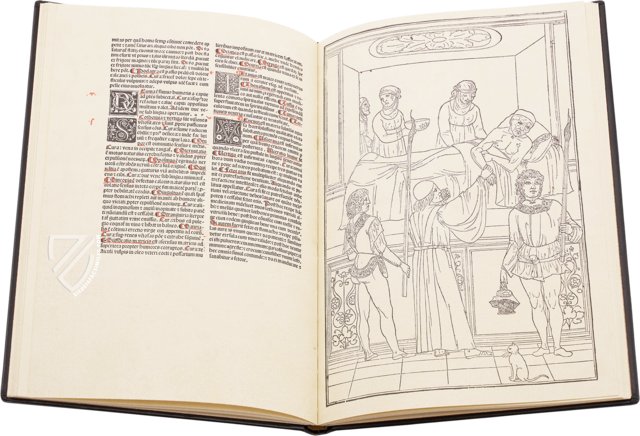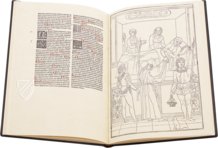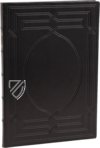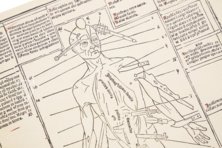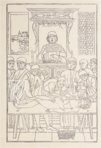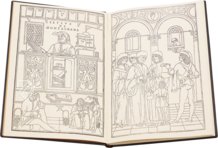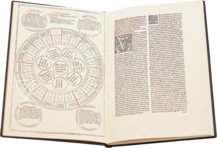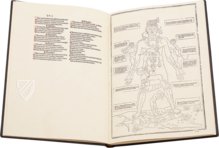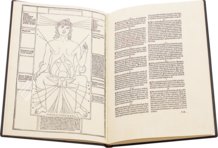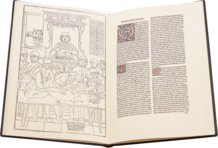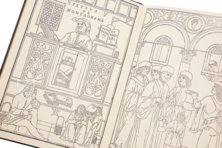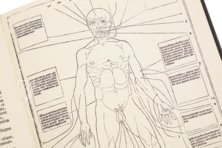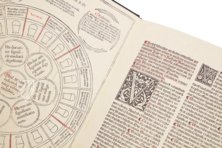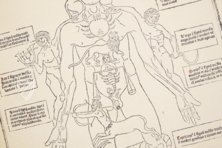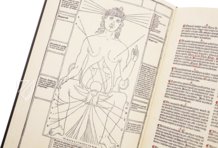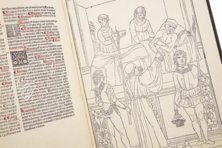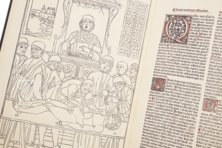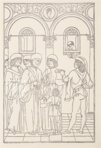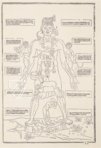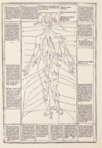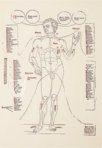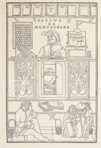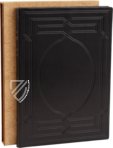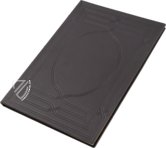Johannes de Ketham: Fasciculus Medicinae
(1,000€ - 3,000€)
The Fasciculus Medicinae is not only one of the earliest printed medical books, but furthermore features 10 remarkable woodcuts that give an insight into body concepts and medical practice in the late Middle Ages. The full-page illustrations depict anatomical representations of human bodies, the treatment of the sick, as well as carers. They complement a collection of medical treatises by famous medieval physicians, who are also depicted as authors and teachers, writing on topics such as surgery, anatomy, childhood diseases, but also the plague. This compilation of texts was first published in 1491 by Johannes de Ketham (c. 1415–1470), a physician practicing in Vienna and later a professor of medicine, in order to make the collected medical knowledge available to a wider professional audience. The Latin work quickly became a veritable bestseller among physicians, leading to translations into Italian and Spanish within a few years and motivating numerous new editions. The second Latin edition of 1495 is also distinguished by the addition of a surgical treatise and more naturalistic woodcuts.
Johannes de Ketham: Fasciculus Medicinae
Johannes de Ketham (c. 1415–1470), born Johannes Kellner von Kirchheim, was a German physician from Kirchheim unter Teck who practiced in Vienna and later became a professor of medicine. It is assumed that he used the Fasciculus Medicinae himself and recommended it in his lectures, as it contains a number of medical treatises well-known among late medieval physicians. These were neither written by him nor did he compile them himself – de Ketham's merit lies in his editorship of the first printed and therefore much more accessible edition of the anthology, whose title means as much as "bundle of medicine".
Anatomy, Plague and Astrology
The compendium offers a remarkable insight into the medical practice of the 15th century by combining ancient and medieval traditions with Renaissance innovations. The treatises address central medical topics that preoccupied the physicians of the time – from the treatment of special diseases such as the plague and diagnostic procedures such as uroscopy, to which a woodcut is dedicated, through anatomy and gynecology to the astrologically correct execution of bloodletting. The treatises are attributed in the work itself to Petrus de Taussignano, Mundinus de Luzzi, Rhazes and Petrus de Montagnana. The latter appears with an explicit inscription on the first woodcut as a writing magister.
A bestseller of the late Middle Ages
The first edition of the Fasciculus Medicinae was published in 1491 by the brothers Giovanni and Gregorio Gregorius in Venice, who already had experience in printing medical incunabula. The work quickly became a bestseller and was not only reprinted in Latin, but also translated into Italian, Spanish and Dutch within a few years. In the around 30 years following its publication, no fewer than 20 new editions were printed. The presented edition of 1495 was also expanded to include a further surgical treatise and is characterized by even more naturalistic woodcuts.
Innovative woodcuts
The ten full-page woodcuts in the work are particularly remarkable: they illustrate the complex topics of the treatises with just a few lines. Particularly impressive are the images of human bodies, whose anatomy is astonishingly naturalistic and which immediately evoke associations with great Renaissance paintings and sculptures, as they also pick up on the ideal of beauty of the time. Some illustrations also show physicians – as teachers, anatomists and practitioners – as well as nurses treating the sick and following medical instructions.
A Glimpse into Medieval Body Images
The Fasciculus Medicinae provides us today with a significant insight into the body images and medical concepts of the Middle Ages through the combination of text and images. In the 15th century, man was still understood with unshakeable certainty as part of the divine world and thus as a microcosm in the macrocosm. Despite medical innovations and the first autopsies, the inside of the body was still a great mystery at this time, with female bodies being particularly taboo and stigmatized. It is therefore not surprising that physicians in the Late Middle Ages and Early Renaissance continued to follow the long-established doctrine of the four humors and astrological rules. Injuries, childhood diseases and the plague were considered particularly threatening at this time, which also reflects the circumstances of that era. The work is therefore an important testimony to late medieval medical history in every respect.
Codicology
- Size / Format
- 80 pages / 32.5 × 23.0 cm
- Origin
- Italy
- Date
- 1495
- Epochs
- Style
- Genre
- Language
- Illustrations
- 10 full-page illustrations
- Content
- Compendium of six different medical treastises
- Patron
- Johannes de Ketham (ca. 1415–1470) (publisher)
- Artist / School
- Giovanni and Gregorio de Gregoriis (printers)
Johannes de Ketham: Fasciculus Medicinae
Uroscopy
Uroscopy – the analysis of urine – was considered to be a doctor’s most important diagnostic tool from antiquity to the early modern period. Medieval medical manuscripts often featured a so-called “urine wheel”, a diagram typically consisting of 20 flasks with different colored urine and the respective diagnoses. Furthermore, the most common depiction of a medieval doctor shows them holding a glass vessel full of urine up to the light. This woodcut, which appears before a page with a urine wheel, shows doctors dressed in the fashion of wealthy German Renaissance burghers debating the proper diagnosis of a urine sample.
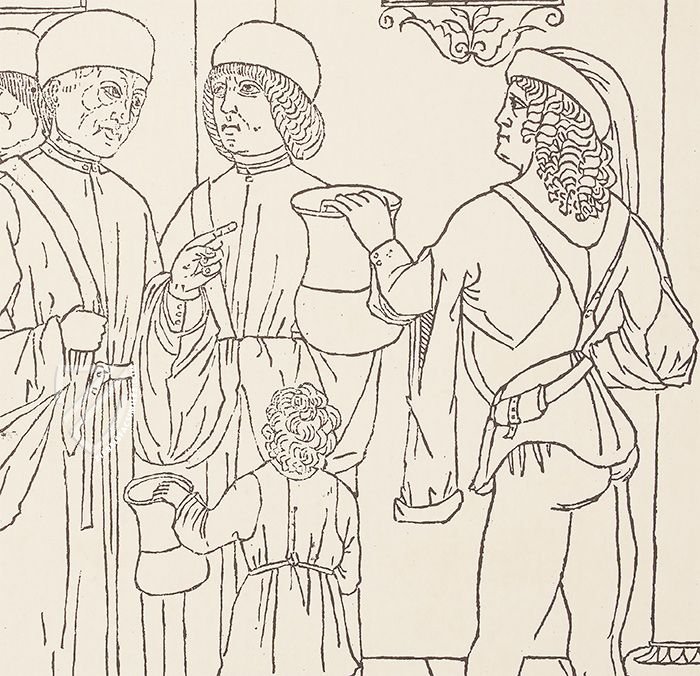
Johannes de Ketham: Fasciculus Medicinae
Autopsy
Violation of the human body was forbidden both by Christianity and the pagan religions of antiquity that proceeded it. However, restrictions on dissecting human bodies for educational purposes began to be relaxed in the Late Middle Ages as the humanist principles of the Renaissance were also embraced by the practitioners of medical science.
Under the supervision of the medical professor who appears throughout the fine woodcuts of this codex, the corpse of a man is laid out on a table and a physician is depicted just as he is about to make the first incision to open up the chest cavity. Two other figures appear to be assisting in the procedure while the rest stand back, observe, and discuss among themselves as this revolutionary lecture is about to begin.
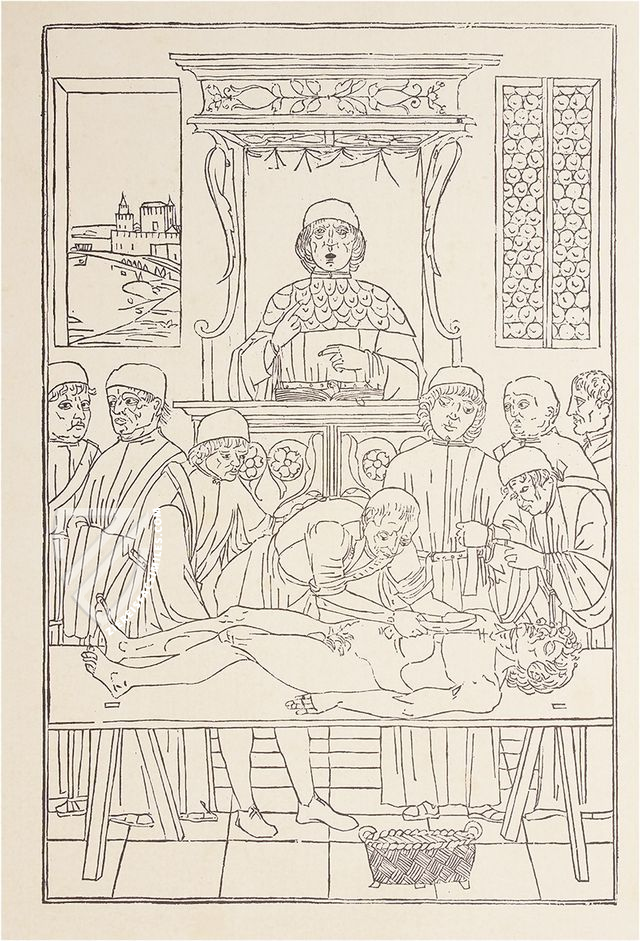
#1 Fasciculus Medicinae
(1,000€ - 3,000€)
- Treatises / Secular Books
- Apocalypses / Beatus
- Astronomy / Astrology
- Bestiaries
- Bibles / Gospels
- Chronicles / History / Law
- Geography / Maps
- Saints' Lives
- Islam / Oriental
- Judaism / Hebrew
- Single Leaf Collections
- Leonardo da Vinci
- Literature / Poetry
- Liturgical Manuscripts
- Medicine / Botany / Alchemy
- Music
- Mythology / Prophecies
- Psalters
- Other Religious Books
- Games / Hunting
- Private Devotion Books
- Other Genres
- Afghanistan
- Armenia
- Austria
- Belgium
- Colombia
- Croatia
- Czech Republic
- Denmark
- Egypt
- Ethiopia
- France
- Germany
- Hungary
- India
- Iran
- Iraq
- Israel
- Italy
- Japan
- Luxembourg
- Mexico
- Morocco
- Netherlands
- Peru
- Poland
- Portugal
- Russia
- Serbia
- Spain
- Sri Lanka
- Sweden
- Switzerland
- Syria
- Turkey
- Ukraine
- United Kingdom
- United States
- Uzbekistan
- Aboca Museum
- Ajuntament de Valencia
- Akademie Verlag
- Akademische Druck- u. Verlagsanstalt (ADEVA)
- Aldo Ausilio Editore - Bottega d’Erasmo
- Alecto Historical Editions
- Alkuin Verlag
- Almqvist & Wiksell
- Amilcare Pizzi
- Andreas & Andreas Verlagsbuchhandlung
- Archa 90
- Archiv Verlag
- Archivi Edizioni
- Arnold Verlag
- ARS
- Ars Magna
- ArtCodex
- AyN Ediciones
- Azimuth Editions
- Badenia Verlag
- Bärenreiter-Verlag
- Belser Verlag
- Belser Verlag / WK Wertkontor
- Benziger Verlag
- Bernardinum Wydawnictwo
- BiblioGemma
- Biblioteca Apostolica Vaticana (Vaticanstadt, Vaticanstadt)
- Bibliotheca Palatina Faksimile Verlag
- Bibliotheca Rara
- Boydell & Brewer
- Bramante Edizioni
- Brepols Publishers
- British Library
- C. Weckesser
- Caixa Catalunya
- Canesi
- CAPSA, Ars Scriptoria
- Caratzas Brothers, Publishers
- Carus Verlag
- Circulo Cientifico
- Club Bibliófilo Versol
- Club du Livre
- CM Editores
- Collegium Graphicum
- Collezione Apocrifa Da Vinci
- Comissão Nacional para as Comemorações dos Descobrimentos Portugueses
- Coron Verlag
- Corvina
- CTHS
- D. S. Brewer
- De Agostini/UTET
- De Schutter
- Deuschle & Stemmle
- Deutscher Verlag für Kunstwissenschaft
- DIAMM
- Droz
- E. Schreiber Graphische Kunstanstalten
- Ediciones Boreal
- Ediciones Grial
- Ediclube
- Edições Inapa
- Edilan
- Editalia
- Edition Georg Popp
- Edition Leipzig
- Edition Libri Illustri
- Editiones Reales Sitios S. L.
- Éditions de l'Oiseau Lyre
- Editions Medicina Rara
- Editorial Casariego
- Editorial Mintzoa
- Editrice Antenore
- Editrice Velar
- Edizioni Edison
- Egeria, S.L.
- Eikon Editores
- Electa
- Enciclopèdia Catalana
- Eos-Verlag
- Ephesus Publishing
- Eugrammia Press
- Extraordinary Editions
- Fackelverlag
- Facsimila Art & Edition
- Facsimile Editions Ltd.
- Facsimilia Art & Edition Ebert KG
- Faksimile Verlag
- Feuermann Verlag
- Folger Shakespeare Library
- Franco Cosimo Panini Editore
- Friedrich Wittig Verlag
- Fundación Hullera Vasco-Leonesa
- G. Braziller
- Gabriele Mazzotta Editore
- Gebr. Mann Verlag
- Gesellschaft für graphische Industrie
- Getty Research Institute
- Giovanni Domenico de Rossi
- Giunti Editore
- Graffiti
- Grafica European Center of Fine Arts
- Guido Pressler
- Guillermo Blazquez
- H. N. Abrams
- Harrassowitz
- Helikon
- Hendrickson Publishers
- Henning Oppermann
- Herder Verlag
- Hes & De Graaf Publishers
- Hoepli
- Hortus Deliciarum
- Houghton Library
- Hugo Schmidt Verlag
- Idion Verlag
- Il Bulino, edizioni d'arte
- ILte
- Imago
- Insel Verlag
- Instituto de Estudios Altoaragoneses
- Instituto Nacional de Antropología e Historia
- Istituto dell'Enciclopedia Italiana - Treccani
- Istituto Ellenico di Studi Bizantini e Postbizantini
- Istituto Geografico De Agostini
- Istituto Poligrafico e Zecca dello Stato
- Italarte Art Establishments
- J. Thorbecke
- Jan Thorbecke Verlag
- Johnson Reprint Corporation
- Jugoslavija
- Karl W. Hiersemann
- Kasper Straube
- Kaydeda Ediciones
- Konrad Kölbl Verlag
- Kurt Wolff Verlag
- La Liberia dello Stato
- La Linea Editrice
- La Meta Editore
- Lambert Schneider
- Landeskreditbank Baden-Württemberg
- Leo S. Olschki
- Les Incunables
- Library of Congress
- Libreria Musicale Italiana
- Lichtdruck
- Lito Immagine Editore
- Lumen Artis
- Lund Humphries
- M. Moleiro Editor
- Maison des Sciences de l'homme et de la société de Poitiers
- Manuscriptum
- Maruzen-Yushodo Co. Ltd.
- MASA
- McGraw-Hill
- Militos
- Millennium Liber
- Müller & Schindler
- National Library of Wales
- Neri Pozza
- Nova Charta
- Oceanum Verlag
- Odeon
- Orbis Mediaevalis
- Orbis Pictus
- Österreichische Staatsdruckerei
- Oxford University Press
- Pageant Books
- Parzellers Buchverlag
- Patrimonio Ediciones
- Pattloch Verlag
- PIAF
- Pieper Verlag
- Plon-Nourrit et cie
- Prestel Verlag
- Princeton University Press
- Prisma Verlag
- Priuli & Verlucca, editori
- Pro Sport Verlag
- Propyläen Verlag
- Pytheas Books
- Quaternio Verlag Luzern
- Reales Sitios
- Recht-Verlag
- Reichert Verlag
- Reichsdruckerei
- Riehn & Reusch
- Roberto Vattori Editore
- Rosenkilde and Bagger
- Roxburghe Club
- Salerno Editrice
- Sarajevo Svjetlost
- Schöck ArtPrint Kft.
- Scolar Press
- Scrinium
- Scripta Maneant
- Scriptorium
- Siloé, arte y bibliofilia
- SISMEL - Edizioni del Galluzzo
- Sociedad Mexicana de Antropología
- Sorli Ediciones
- Stainer and Bell
- Styria Verlag
- Sumptibus Pragopress
- Szegedi Tudomànyegyetem
- Taberna Libraria
- Tarshish Books
- Taschen
- Tempus Libri
- Testimonio Compañía Editorial
- Thames and Hudson
- The Clear Vue Publishing Partnership Limited
- The Facsimile Codex
- The Folio Society
- The Marquess of Normanby
- The Richard III and Yorkist History Trust
- Tip.Le.Co
- TouchArt
- TREC Publishing House
- TRI Publishing Co.
- Trident Editore
- Typis Regiae Officinae Polygraphicae
- Universidad de Granada
- University of California Press
- University of Chicago Press
- Urs Graf
- Vallecchi
- Van Wijnen
- VCH, Acta Humaniora
- VDI Verlag
- Verlag für Regionalgeschichte
- Verlag Styria
- Vicent Garcia Editores
- W. Turnowsky
- Wiener Mechitharisten-Congregation (Wien, Österreich)
- Wissenschaftliche Buchgesellschaft
- Xuntanza Editorial
- Zollikofer AG

